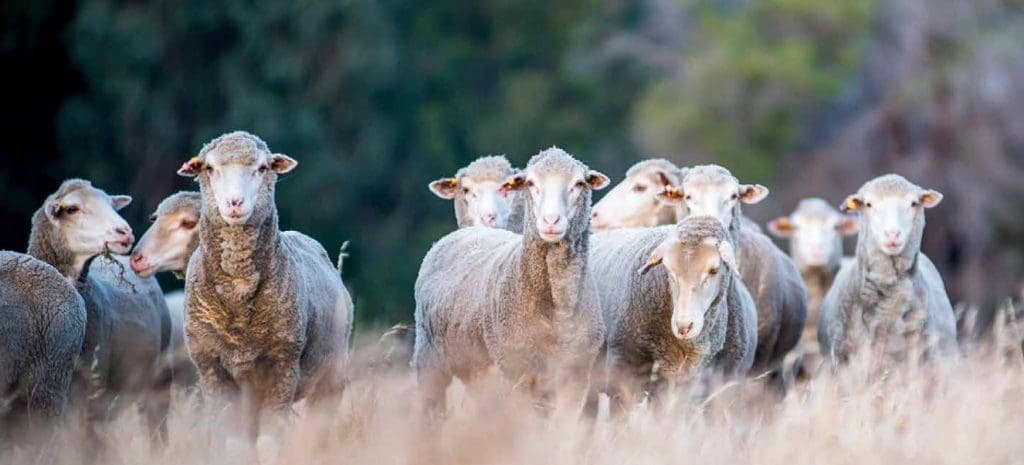
MLA is considering a new Genetic Resource Flock funding model Image – MLA.
MEAT & Livestock Australia is considering new funding options for the sheep industry’s valuable genetic resource flock, potentially through the MLA Donor Company.
A consultation process on funding options has some breeders concerned MLA is considering pulling out of levy funding the GRF, formerly known as the Sheep CRC’s Information Nucleus Flock.
One breeder contacted Sheep Central concerned an MDC-funded model would have implications for breeders collaborating with the GRF and expose the flock’s future to the funding priorities of the Federal Government.
“The great risk is that we end up with no resource flock and the industry would be reliant on private trials to effect the genetics of the Australian flock, which would have governance issues.”
The breeder said it is important an independent research flock be maintained as a genetic benchmark for all other research and it should not rely on government funding.
“The information nucleus flock is there for the benefit of all lamb producers and lamb levies should pay for that because the information that comes out of it benefits everybody in the lamb industry.
“I don’t think it should be a government thing, I think industry should support it.”
An MLA spokesperson said MLA is exploring investment options to fund the resource flock.
“Investment through the MLA Donor Company would present an opportunity to leverage and extend available funds in a way that enables MLA to support a broad range of research project investments,” the spokesperson said.
Since 2014, MLA has invested $12 million in lamb levies into the MLA Resource Flock.
“This has enabled the development of single-step genomic genetic evaluations for hard to measure traits including eating quality, reproduction and parasite resistance.
“The MLA Resource Flock also underpins the accuracy of these hard-to-measure traits as part of the routine Sheep Genetics evaluations,” the spokesperson said.
“It continues to provide a valuable animal resource for trait capture for new traits such as methane and feed intake.
“Measurement of these traits has been overlayed on the MLA Resource Flock through two additional MLA investments.”
The spokesperson said MLA is committed to the funding of sheep reference populations and the Livestock Genetics program.
“The current MLA Resource Flock is undergoing a project variation to enable an additional cohort of animals to be measured and funded using lamb levies.
“The Resource Flock remains a priority for MLA,” the spokesperson said.
“To maximise industry impact, MLA continues to examine a range of funding opportunities.
“MLA recognises that ongoing data capture is required to underpin the accuracy of genomic predictions and while a small amount of private good is derived from contributing animals to the Resource Flock there is significant industry good,” the spokesperson said.
“This concept is important and is being considered when looking for future funding collaborators.
“It is worth noting that the beef industry has been operating reference populations through the MDC for a number of years,” the spokesperson said.
“There has not been levy investment in cattle reference populations for some time.”
The spokesperson said there have been discussions with service providers and ram producers about GRF funding options.
“Further consultation will occur before any changes are made.
“MLA has been exploring options at this stage for future resource flock investments with current service providers/research organisations that operate the resource flock,” the spokesperson said.
“These options have been shared with some breeder groups during recent forums where the Sheep Genetics team has been present to gather industry feedback.
“Sheep Genetics also operates an Advisory Committee whose membership represents breeders and service providers and is utilised to provide guidance and industry feedback on developments within Sheep Genetics.”
The spokesperson said the National Livestock Genetics Consortium is the other industry consultation forum in place to support MLA in prioritising research investments and ensuring the greatest impact is achieved from the research levy or MDC investments.
About the resource flock
The MLA Resource Flock first began as the Sheep CRC Information Nucleus Flock (INF) in 2007 and ran for five years until 2012. Over these five years, there was a large number of traits collected every year on the progeny of 5000 ewes that were joined to over 100 industry sires annually.
This trait data has informed the Australian Sheep Breeding Values that underpin the nation’s sheep genetic evaluation systems — MERINOSELECT for Merino producers and LAMPLAN for maternal and terminal breeders.
From 2012, the MLA Resource Flock commenced and began collecting traits that are hard to measure (phenotypes) and genotypes on the progeny of sires nominated from the industry by breeders.
In addition to underpinning genomic reference populations, the resource flocks are used for numerous other experiments, these include:
- testing the effects of stress on meat phenotypes
- calibration of carcase and meat quality measurement devices.

HAVE YOUR SAY